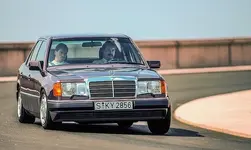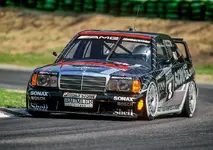Mercedes-Benz, the world’s oldest luxury car manufacturer, has been reinventing the automobile over and over since 1886. As it does so, the brand continually sets new standards while also keeping pace with social change. The history of the company is correspondingly rich in events and stories. Here we have a brief summary of some important anniversaries and milestones from its history.

1 October 1992 – 30 years ago
European premiere of the Mercedes-Benz 400 E of the 124 model series
2 October 1992 – 30 years ago
Large-scale electric vehicle project on the island of Rügen
7 October 1992 – 30 years ago
The Mercedes-Benz S-Class of the 140 model series became “World Car 1992”
11 October 1992 – 30 years ago
Klaus Ludwig became German Touring Car Champion 1992
3 November 1897 – 125 years ago
Maiden voyage of the world’s first all-metal airship with Daimler engine
Mercedes-Benz Classic Magazine 2/2022
The fascination of Mercedes-Benz inspires generations
Media representatives can view and download the latest Mercedes-Benz Classic Magazine at media.mercedes-benz.com/magazine.
Birthdays












Additional information, entire press article(s), directly from its original source: Daimler AG
1 October 1992 – 30 years ago
European premiere of the Mercedes-Benz 400 E of the 124 model series
- V8 sophistication in the inconspicuous dress of the upper mid-size class
- Particularly successful in North America
- Adaptation of bodyshell structure, suspension, brakes and exhaust system
2 October 1992 – 30 years ago
Large-scale electric vehicle project on the island of Rügen
- Field test for electric mobility with passenger cars and vans
- 201 model series saloons are given different battery-motor combinations
- Reliable operation with annual mileages of up to 100,000 kilometres
7 October 1992 – 30 years ago
The Mercedes-Benz S-Class of the 140 model series became “World Car 1992”
- The award ceremony took place at the Paris Motor Show
- The 300 SE 2.8 and the 300 SD rounded off the model range
- Since 2021, well-maintained early units of the 140 model series have been considered historical cultural assets
11 October 1992 – 30 years ago
Klaus Ludwig became German Touring Car Champion 1992
- First title and triple success in the drivers’ championship for Mercedes-Benz
- Klaus Ludwig won in five races with the 190 E “Evo II”
- Second title in a row for Mercedes-Benz as constructors’ champion
3 November 1897 – 125 years ago
Maiden voyage of the world’s first all-metal airship with Daimler engine
- Anniversaries for aircraft engines built by the Daimler-Motoren-Gesellschaft and Benz & Cie.
- First rigid airship in history takes off from Berlin
- Klemm-Daimler L 20 light aircraft in the Mercedes-Benz Museum
Mercedes-Benz Classic Magazine 2/2022
The fascination of Mercedes-Benz inspires generations
- The brand’s vehicles captivate young and old alike
- Detailed stories offer a colourful bouquet of the best reading material
- Available by subscription or as single issue at
mercedes-benz.com/en/exclusive/classic-magazine/subscription as well as in the shops of the Mercedes-Benz Museum and the factories
Media representatives can view and download the latest Mercedes-Benz Classic Magazine at media.mercedes-benz.com/magazine.
Birthdays
- 80 years ago – Jutta Benz, born on 1 October 1942. The great-granddaughter of Bertha and Carl Benz is a Brand Ambassador for Mercedes-Benz. She is the last bearer of the Benz family name, which goes back in direct line to the automobile pioneer and his wife.
- 70 years ago – Norbert Haug, born on 24 November 1952. The motorsport boss was responsible for the company’s activities in Formula 1, DTM, Group C and Formula 3 from 1990 until 2013. He brought Mercedes-Benz back to the top of international racing.












Additional information, entire press article(s), directly from its original source: Daimler AG